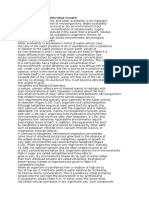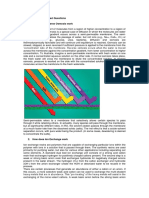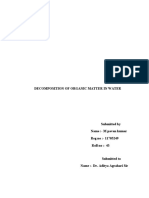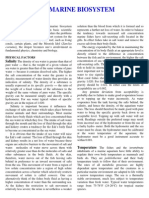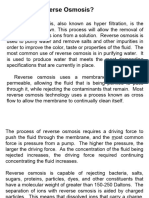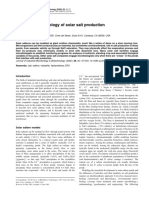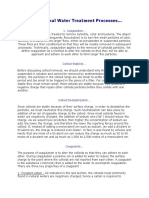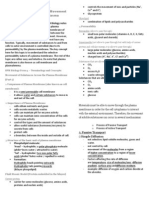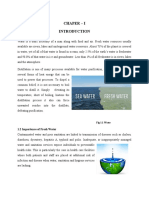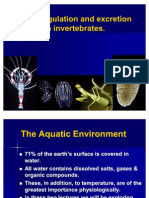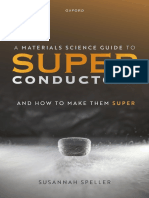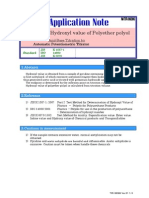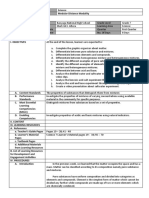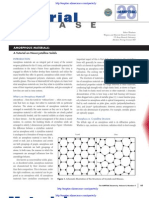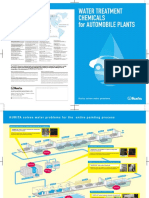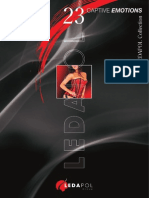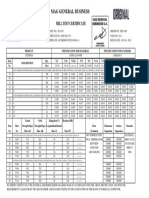Halophiles
Halophiles
Uploaded by
Hardik ShahCopyright:
Available Formats
Halophiles
Halophiles
Uploaded by
Hardik ShahCopyright
Available Formats
Share this document
Did you find this document useful?
Is this content inappropriate?
Copyright:
Available Formats
Halophiles
Halophiles
Uploaded by
Hardik ShahCopyright:
Available Formats
HALOPHILES
INTRODUCTION
Aquatic environments:
Fresh waters: less than 0.05% w/v dissolved salts Sea waters: total salinity 3.2-3.8% w/v Saturated salt solutions: up to 30% and above
In freshwater- extracellular solute conc. is low dilution stress swelling osmotic lysis. Lysis is prevented by c.w. develop positive hydrostatic pressure restricting water entry and cell enlargement. Wall less bac. counteract such water uptake by using contractile vacuoles to concentrate and remove water. In sea water, microbes faces osmotic and salt combined stress. Microbes counterbalance by the intracellular accumulation of solutes to an equivalent osmotic level. Extreme environments includes non ionic environments of high osmotic strength.
MICROBIAL DIVERSITY IN HYPERSALINE ENVIRONMENT
Bacteria
Halobacterium (Gram negative elongated rods, > 2M NaCl) Halococcus (thick walled Gram positive coccus, > 2M NaCl) Ectothiorhodospira (Anaerobic, phototroph, > 1.5 M NaCl, optimum 3M NaCl)
Cyanobacteria
Synechococcus Synechocystis Dactylococcopsis
Eukaryotic photosynthetic flagellates
Chlamydomonas Dunaliella Asteromonas
Halobacterium and Halococcus: aerobic (heterotrophic) mode of growth - absolute requirement of salt about 2 M or higher - pink or red pigmentation lack of peptidoglycan preference of aminoacids as source of fixed carbon for energy metabolism.
Halobacterium ruburum: capacity of photophosphorylation via pigment bacteriorhodopsin under anaerobic of microaerophilic conditions.
Ectothiorhodospira halochloris: spiral shaped rods flagellated, bipolar contain stacked intracytoplasmic membranes (sites of pigment localization) grow best with H2O as ele donor and CO2 as C-source.
Dactylococcopsis salina cyanobact slender, fusiform rods (~80mm long) granular cytoplasm no growth at salt conc below sea water.
Synechococcus cyanobact - no sheath surrounding cell single plane halo philic/tolerant.
Synechocystis cyanobact lack of sheath cell division in two or three planes.
Dunaliella biflagellate, unicellular green algae lack rigid polysaccharide c.w. grow over wide range of salt concentrations halo phile/tolerant.
PRINCIPLES OF HALOTOLERANCE AND HALOPHILISM
Adaptations are classified in to three broad catagories. Insulation:
Adaptations reducing the impact of the external environment by preventing entry of salt. Feature of c.w and/or p.m.
Protection:
Protecting intracellular function and metabolic activity from inhibiting effect of Na+.
Modification:
Aspect of cellular metabolism showing optimal function in high salt conditions.
INSULATION
High conc of Na+ - toxic to most biological systems. Most bac, fungi and alga possess
memb. with low permeability to Na+ than to K+. Active Na+ extrusion mechanism.
Halobacterium cells
contains 0.36-3.6 M NaCl on growing media with 3.3 to 5.1 M. more K + than Na+. Na + -K + ratio is 0.1-0.2(0.7 in stationary phase). Show activ Na + extrusion (efflux linked to proton entry) P.m. has low passive Na + permeability.
Dunaliella has
low internal Na + conc growing in high salt media may be two compartment system with inner well insulated & outer leaky compartment. So, low internal Na + levels and low passive + permeability.
Intracellular accumulation of K + also occurs in halotolerant cyanobac and in Dunaliella (not in same extent as Halobacterium). All halophilic and halotolerant mos show some degree of insulation of the cell interior from external Na + varying between orgs.
Alternative compounds also used to generate intracellular solutes providing turgor pressure (esp in cells lacking rigid cell wall).
In Halobacterium and Halococcus this additional solute is K + . Photoautotrophs accumulates organic solutes rather than inorganic ions to achieve osmotic bal.
Dunaliella synthesizes glycerol when grown on saline medium. In some cyanobacteria, quaternary ammonium compound glycine betaine is principle intracellular solute while in some glutamate betaine is major (in Calothrix genus).
Polyols and other organic molecules are not inhibitory for enzyme activity at various concentrations.
Term Compatible solute has been used to describe all compounds showing this feature of compatibility. First demonstrated for polyols in sugar tolerant yeasts and for glycerol in Dunaliella. In Cynechocystis glycine betaine acts as compatible solute did not inhibit enzymes at 2 M conc. Halophile/tolerant mos requires enzyme to function in environment of high ionic strength with KCl (less effective inhibitor than NaCl) acting as compatible solute.
Except halobacterium and halococcus, organic solutes generally found as intracellular solutes. Diverse range of carbohydrates, amino acids, quaternary ammonium and tertiary sulphonium compounds and related molecules are employed by salt stressed organisms to effect osmotic salt stress.
Osmotic adjustment occurs in response to changes in external water states rather than to specific ionic effects. Level of compatible solute is sensitive to changes in external osmolarity. It increases in response to upshock (increase in external salt conc.) and decrease in response to downshock (decrease in external salt conc.). Osmoregulation: change in intracellular solute concentration in response to outer environment and the processes involved in this adjustment.
PROTECTION
Halotolerant and halophilic mos maintains low intracellular Na+ concentrations by combination of low plasma membrane Na+ permeability and active Na+ extrusion. As compared to freshwater and marine bac (<0.05M), halotolerant cyanobac contain 0.1 0.3 M internal Na+ levels. Mos growing at high external NaCl conc may be faced with combination of
Lowered intracellular water potential and Increased internal Na+ content ( insulation is less than 100% effective)
Compatible solute theory had been extended to include aspects of salt and osmotic stress. Water like hydroxyl groups of polyols (glycerol and mannitol) can replace water molecules and thus maintain hydrophobicity enforced water structure within cytoplasm under lowered cellular water potential. Similar functions can be played from quaternary ammonium compounds and imino acid proline. Glycine betaine can partially protect enzymes (e.g. melate dehydrogenase in Hordeum vulgare) and in some cases it can increase enzyme activity (e.g. in Synechocystic DUN52, 1 to 1.2 M betaine increased activity of glutamine synthatase by 24% and 28% respectively) Above discussion is applied to salt adapted cells.
Salt inactivation can occur on initial transfer to saline medium(rapid sodium entry within 2 min).
Most of the cells responds to this upshock and new low steady state is achieved within 30 min. this time course may be extended till extrusion of Na+. Na+ extrusion is energy dependent and sensitive to external K+ concentration. It shows that intracellular osmotica may be involved in protection against NaCl inactivation in short term following upshock. So, orgs containing high compatible solutes may well show less Na+ inhibition upon transfer to high salt medium than orgs containing lower levels of organic osmotica. It can be considered as possible training of mos to grow in hypersaline media.
For protection against Na+ toxicity orgs will be dependent on the extent of insulation against NaCl entry at O.M. Compatible (organic) osmotica may be also involved in
Maintainance of cytoplasmic water structure Protection against transient increase in intracellular salt levels.
MODIFICATION
You might also like
- Synthesis of Copper Hydroxide Lab ReportDocument27 pagesSynthesis of Copper Hydroxide Lab Reportapi-441462150No ratings yet
- Biocide TestingDocument9 pagesBiocide TestingVlassis SarantinosNo ratings yet
- IP4. Separation and Classification of SolidsDocument23 pagesIP4. Separation and Classification of SolidsYzon Aldwin Gundran Balag100% (1)
- Lecture 4. Factors Affecting Microbial GrowthDocument12 pagesLecture 4. Factors Affecting Microbial GrowthOnur KayaNo ratings yet
- Salinity Tolerance in PlantsDocument26 pagesSalinity Tolerance in PlantsBrza RajputNo ratings yet
- Aerated LagoonsDocument10 pagesAerated Lagoonsnp27031990No ratings yet
- Osmolarity and Microbial GrowthDocument2 pagesOsmolarity and Microbial GrowthelixNo ratings yet
- Life at Low Water Activity: References Email Alerting ServiceDocument20 pagesLife at Low Water Activity: References Email Alerting Serviceteddy_constantinNo ratings yet
- U3L4Document21 pagesU3L4csirnet130No ratings yet
- Water: Frequently Asked Questions 1. How Does Reverse Osmosis WorkDocument8 pagesWater: Frequently Asked Questions 1. How Does Reverse Osmosis WorkZainal HashimNo ratings yet
- Environmental Effects of SurfactantsDocument11 pagesEnvironmental Effects of Surfactantstalready69No ratings yet
- Salting Out: 1. Last Updated Save As PDF Share Share Share Tweet Share Page IDDocument8 pagesSalting Out: 1. Last Updated Save As PDF Share Share Share Tweet Share Page IDveronicaNo ratings yet
- Salting Out: 1. Last Updated Save As PDF Share Share Share Tweet Share Page IDDocument8 pagesSalting Out: 1. Last Updated Save As PDF Share Share Share Tweet Share Page IDveronicaNo ratings yet
- Oren 2015Document18 pagesOren 2015rini susilowatiNo ratings yet
- DiffusionDocument2 pagesDiffusionanisolai3000No ratings yet
- SALT TOLERANT CROPSDocument31 pagesSALT TOLERANT CROPSSubramanya HaraneNo ratings yet
- Cell DisruptionDocument14 pagesCell DisruptionAathira AjeeshNo ratings yet
- Decomposition of Organic Matter in WaterDocument6 pagesDecomposition of Organic Matter in WaterDivya Reddy100% (1)
- Chemical Properties of Water Lec 3 FinalDocument42 pagesChemical Properties of Water Lec 3 FinalMaha Afzal100% (1)
- Detergents: Triton X-100, Tween-20, and More: Type ChemicalsDocument13 pagesDetergents: Triton X-100, Tween-20, and More: Type ChemicalsAlvaro Ivan Arias GonzalezNo ratings yet
- Green Scale Control InhibitorDocument7 pagesGreen Scale Control InhibitorNarathip PradidpholNo ratings yet
- QuestionsDocument5 pagesQuestionsTims WatsonsssNo ratings yet
- Standard Electrode Potentials Nernst Equation: Conductivity (Or Specific Conductance) of AnDocument5 pagesStandard Electrode Potentials Nernst Equation: Conductivity (Or Specific Conductance) of AnKent John Mañas SeratoNo ratings yet
- N. Fajri Usman SEH110704 Assignment 1 SHEH 2105: Environmental Chemical AnalysisDocument5 pagesN. Fajri Usman SEH110704 Assignment 1 SHEH 2105: Environmental Chemical AnalysisFajri UsmanNo ratings yet
- The Marine BiosystemDocument3 pagesThe Marine BiosystemsutisnagustikomangNo ratings yet
- Chemrj 2016 01 04 161 164Document4 pagesChemrj 2016 01 04 161 164editor chemrjNo ratings yet
- What Is Reverse Osmosis?Document30 pagesWhat Is Reverse Osmosis?gulfengsolutionsNo ratings yet
- New Microsoft Word DocumentDocument4 pagesNew Microsoft Word DocumentNivas KaruppananNo ratings yet
- Expert Essay 7Document3 pagesExpert Essay 7MuhammadMansoorGoharNo ratings yet
- Absorption: AbsoluteDocument47 pagesAbsorption: AbsoluteVel MuruganNo ratings yet
- Halotolerant BacteriaDocument47 pagesHalotolerant BacteriasilvaNo ratings yet
- Chapter03 MicroDocument56 pagesChapter03 Micronavidhah 22No ratings yet
- 21Document8 pages21yosraNo ratings yet
- Data PreprocessingDocument6 pagesData PreprocessingAnonymous VNu3ODGavNo ratings yet
- Ben Hamed 2014Document9 pagesBen Hamed 2014ArtNo ratings yet
- Awareness About The RO Water PurifierDocument7 pagesAwareness About The RO Water PurifiervikaskamaljnuNo ratings yet
- 9661Document12 pages9661yosraNo ratings yet
- Glossary of Some of The Terms Used MetaboliteDocument18 pagesGlossary of Some of The Terms Used MetaboliteSri AgustinaNo ratings yet
- Conventional Water Treatment Processes PDFDocument18 pagesConventional Water Treatment Processes PDFSayan KirinathanNo ratings yet
- TMP 8 B54Document8 pagesTMP 8 B54FrontiersNo ratings yet
- SPM Biology Form 4 NotesDocument3 pagesSPM Biology Form 4 NotesDelima Adan86% (7)
- SEV455 Assignment 1A-BusikuDocument7 pagesSEV455 Assignment 1A-BusikuBusiku SilengaNo ratings yet
- Salt and Drought StressDocument7 pagesSalt and Drought StressAbdul Rehman AhmadNo ratings yet
- Experiment #03: 3.2 TheoryDocument6 pagesExperiment #03: 3.2 TheorymjunaidNo ratings yet
- BIOMOLECULESDocument91 pagesBIOMOLECULESFurret MasterNo ratings yet
- Aquaculture: Si-Yin Han, Meng-Qiang Wang, Mei Liu, Bao-Jie Wang, Ke-Yong Jiang, Lei WangDocument9 pagesAquaculture: Si-Yin Han, Meng-Qiang Wang, Mei Liu, Bao-Jie Wang, Ke-Yong Jiang, Lei WangMuchammadIbrahimUlilAbshorNo ratings yet
- Seawater DesalinationDocument4 pagesSeawater DesalinationNha KhuongNo ratings yet
- Water PurificationDocument9 pagesWater Purificationsbhuvan2662No ratings yet
- Renal Physiology BY Dr. Olasupo. S. AdeniyiDocument6 pagesRenal Physiology BY Dr. Olasupo. S. AdeniyiUloko ChristopherNo ratings yet
- Jar Test Lab ReportDocument20 pagesJar Test Lab ReportMohd Syafiq Akmal100% (1)
- 1 Osmosis DialysisDocument5 pages1 Osmosis DialysisRio SurNo ratings yet
- J T Machinya Isolation and Characterisation of Bacteria Practical FinalDocument16 pagesJ T Machinya Isolation and Characterisation of Bacteria Practical FinalJohnMachinyaNo ratings yet
- Review Article: Mechanism of Salinity Tolerance in Plants: Physiological, Biochemical, and Molecular CharacterizationDocument19 pagesReview Article: Mechanism of Salinity Tolerance in Plants: Physiological, Biochemical, and Molecular CharacterizationJavier Cobos MoraNo ratings yet
- Amb 461Document7 pagesAmb 461Chukwuebuka NwaforNo ratings yet
- 10 Wastewater Environmental Term GlossaryDocument20 pages10 Wastewater Environmental Term GlossaryRaul CordovaNo ratings yet
- Lecture 3 - Coagulation and FlocculationDocument93 pagesLecture 3 - Coagulation and FlocculationChuah Chong YangNo ratings yet
- UOP Extending Molecular Sieve Life Tech PaperDocument7 pagesUOP Extending Molecular Sieve Life Tech PaperOmar EzzatNo ratings yet
- CHAPTER-1 FinalisedDocument19 pagesCHAPTER-1 FinalisedShyam SundarNo ratings yet
- Reverse Osmosis: Improve It Talk Page Citations Verification Cleanup Quality StandardsDocument22 pagesReverse Osmosis: Improve It Talk Page Citations Verification Cleanup Quality StandardsshanuthegreatNo ratings yet
- Ece3204 Group 2Document14 pagesEce3204 Group 2HendrixNo ratings yet
- 7.osmoregulation and Excretion in Invertebrates - FinalDocument58 pages7.osmoregulation and Excretion in Invertebrates - FinalAhmed Oraby81% (16)
- 2016 Expansive Soil Characterisation An AppraisalDocument5 pages2016 Expansive Soil Characterisation An AppraisalS R Kumar KonathalaNo ratings yet
- A Materials Science Guide To Superconductors - and How To Make Them SuperDocument241 pagesA Materials Science Guide To Superconductors - and How To Make Them Superudit Kumar100% (1)
- Boiler PlateDocument2 pagesBoiler PlateshazanNo ratings yet
- CFD Analysis of Frictional Drag Reduction On The Underneath of Ship's Hull Using Air Lubrication SystemDocument10 pagesCFD Analysis of Frictional Drag Reduction On The Underneath of Ship's Hull Using Air Lubrication SystemSasikumar yedidaNo ratings yet
- Btu Min Btu Min Btu Min Btu Min 2 2 2 2 2Document8 pagesBtu Min Btu Min Btu Min Btu Min 2 2 2 2 2Elisif DeFair100% (1)
- OH Determination For Polyether PolyolDocument4 pagesOH Determination For Polyether PolyolHoang Cong ThanhNo ratings yet
- Lesson Exemplar Science Melc 3Document6 pagesLesson Exemplar Science Melc 3Mark Gil Jalbuena AltezaNo ratings yet
- How To Study HSCDocument2 pagesHow To Study HSCNitin MorajkarNo ratings yet
- Amorphous MaterialsDocument5 pagesAmorphous MaterialsmaridassNo ratings yet
- Analytical Chemistry Lab CHDocument22 pagesAnalytical Chemistry Lab CHm.shehroz8898No ratings yet
- Yr 10 Ls 1 MixturesDocument10 pagesYr 10 Ls 1 Mixturesdhanya chakkalakkalNo ratings yet
- Standardization of HCLDocument9 pagesStandardization of HCLSuscyn CondrillonNo ratings yet
- 3 Microencapsulation Techniques: Sign in To Download Hi-Res ImageDocument38 pages3 Microencapsulation Techniques: Sign in To Download Hi-Res Imagema2986No ratings yet
- Hess' Law Mgso4 FinalDocument6 pagesHess' Law Mgso4 FinalAtikah OlivaNo ratings yet
- Bits Pilani - K. K. Birla Goa Campus SEMESTER - I, 2021-2022 Course Handout - IIDocument2 pagesBits Pilani - K. K. Birla Goa Campus SEMESTER - I, 2021-2022 Course Handout - IINoel PrashantNo ratings yet
- Questions On Instrument AirDocument4 pagesQuestions On Instrument AirShazeem HoseinNo ratings yet
- Photoelastic CoatingsDocument103 pagesPhotoelastic CoatingsBenon MugiranezaNo ratings yet
- Chemical Reaction With QDocument5 pagesChemical Reaction With QJitendra KumarNo ratings yet
- Session 58 Theory of Composite AnalysisDocument11 pagesSession 58 Theory of Composite AnalysisrajuNo ratings yet
- FDA 483 - Aurobindo Pharma Unit IX Telangana, IndiaDocument17 pagesFDA 483 - Aurobindo Pharma Unit IX Telangana, IndiaFaisalNo ratings yet
- Approval of Powder Coatings - Quick Guide: Working Group of Technical CommitteeDocument6 pagesApproval of Powder Coatings - Quick Guide: Working Group of Technical CommitteeF.Javier LobeiraNo ratings yet
- Chemical Product Line Up For AutomotiveDocument4 pagesChemical Product Line Up For AutomotiveLuan NguyenNo ratings yet
- Ledapol Basic Lingerie and Clothing Collection 23Document108 pagesLedapol Basic Lingerie and Clothing Collection 23Latex, Leather and Lace100% (1)
- Certificado de Calidad Caps SCH-40Document1 pageCertificado de Calidad Caps SCH-40Jesus CondoriNo ratings yet
- Chapter 01 2SPPDocument46 pagesChapter 01 2SPPHyxeste John MoñizaNo ratings yet
- CHAP 4 Com Tech Nucleic Acid Extraction MethodsDocument8 pagesCHAP 4 Com Tech Nucleic Acid Extraction MethodsALLISON PAMITTANNo ratings yet
- Tai Lieu Chuan Clo DuDocument4 pagesTai Lieu Chuan Clo DuCuong CaoNo ratings yet
- Solenoid Valves Basics - 02Document1 pageSolenoid Valves Basics - 02renvNo ratings yet






